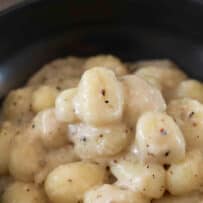Cacio e Pepe Gnocchi
With only 3 simple ingredients, this Cacio e Pepe Gnocchi is a twist on the Italian classic that’s traditionally made with spaghetti. I’m sharing my tips to achieve the creamiest Cacio e Pepe this side of the Atlantic Ocean.
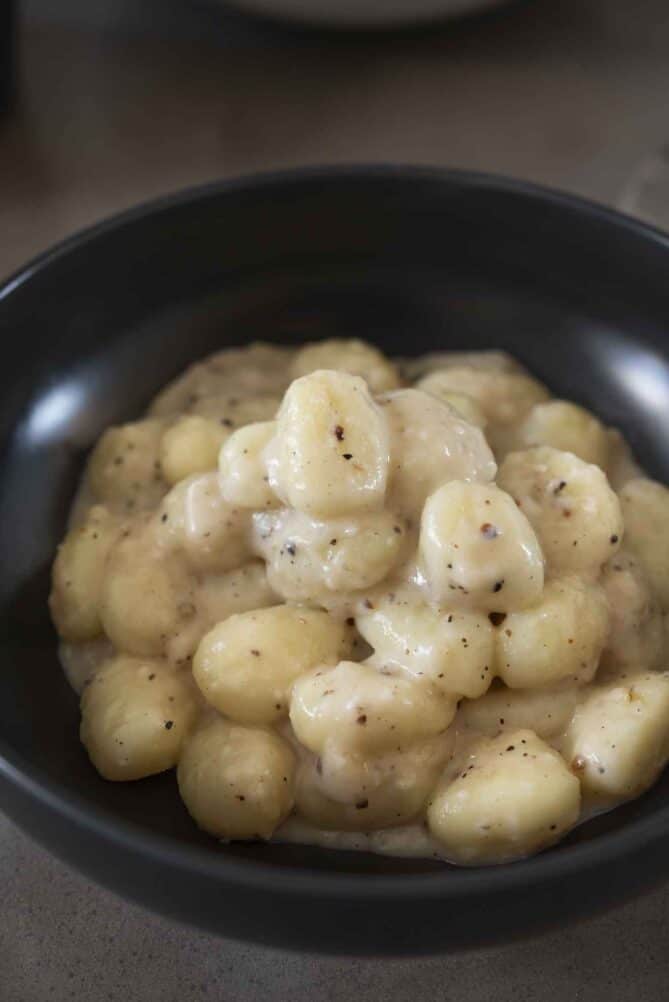
Yes, I’ve finally jumped on the Cacio e Pepe (pronounced kaa-chee-ow-ee-pe-pay) viral train. It seems people have been going crazy for this Italian (specifically Roman) dish lately, causing a global frenzy as you’ll now see it on menu’s at casual neighborhood Italian restaurants all the way up to Michelin star restaurants!
Why is Cacio e Pepe so popular?
What caused the global obsession for it? After all, it’s just pasta, cheese and pepper? Well, really good Roman, sharp, sheep’s milk cheese to be precise and fresh ground pepper. Could it be it’s one of the easiest and tastiest authentic Italian dishes?
Cacio e Pepe without butter or cream
Just like Spaghetti Carbonara, you do not add butter or cream to Cacio e Pepe. Just do like the Italians do. They’ve been doing it right for centuries. Plus, I don’t want to get yelled at by my Italian in-laws!
Traditional Cacio e Pepe Sauce
My sauce recipe and method is exactly how it’s made in Italy – with no butter ever and definitely no cream! Think of it as a rich, cheesy and very creamy dish and with the substitution of gnocchi, it’s like gourmet, comforting Mac and Cheese.
It’s a slight departure in texture from spaghetti by using pillowy soft gnocchi, but it is so good! A mention about the cheese that’s used. Pecorino Romano is a much stronger, pungent tasting cheese than Parmesan. Cacio e Pepe (which literally translates to cheese and black pepper) sauce is a saltier, richer and way more peppery version of an Alfredo.
We’re going to go deep here and I’ve done all the R & D (research and development) for you. I’ve already made all the mistakes for you so you don’t have to take them on! My research and trial and error was done in my test kitchen so I can share all my tips and tricks so you too can achieve the perfect Cacio e Pepe.

I know what you’re thinking… what? It’s just pasta, cheese and pepper! But, the dish has less to do with the ingredients and everything to do with execution and preparation and this is one of those dishes that is much more science than art!
The dish is famous for being, well, famous. But, it’s even more famous for its ability for the preparation to go wrong. And when it does go wrong, it does so very quickly! Read on and you’ll see that it went wrong for me a few times…
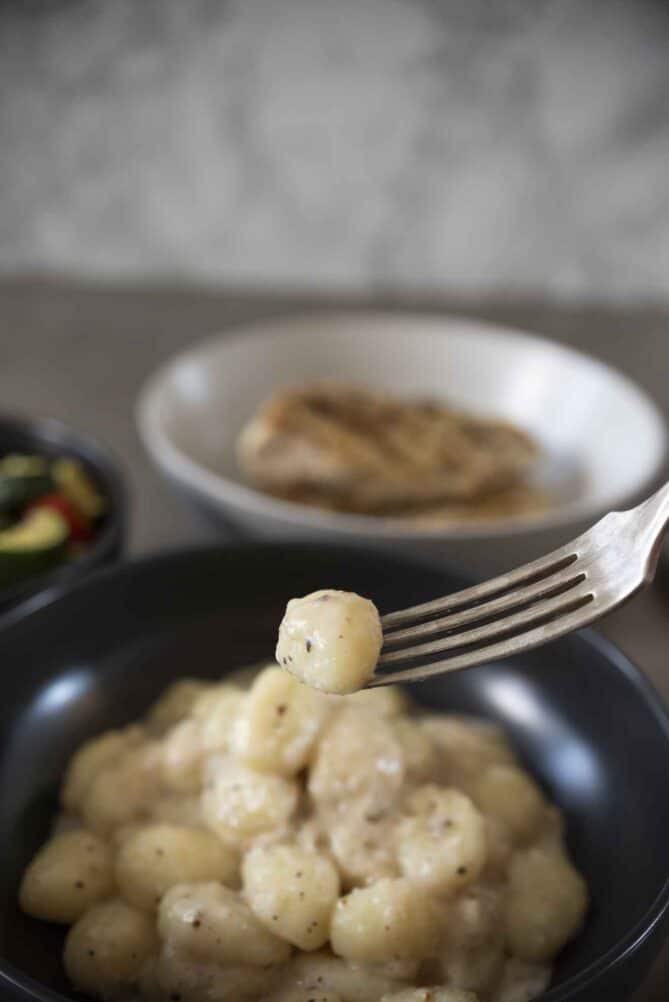
How To Get Cacio e Pepe Right
OK, let’s dive in. As mentioned above, this 3 ingredient dish can be easy, but it is also easy to get it wrong as there is a little science involved. It’s about getting a perfectly emulsified sauce and that’s where the science part comes in. Temperature is crucial as too much heat can break the sauce.
Two very important factors are room temperature cheese and cooking water that is not too hot! Water temperature should be 158°F/ 70°C degrees, if you want to be precise, and you do with this one. I also believe that a key step that leads to success is making a paste with the grated cheese and the cooking water before adding to the gnocchi to help make the marriage a happy one.
Cacio e Pepe Gnocchi with Homemade Gnocchi
I don’t always make my own gnocchi as packaged gnocchi is so convenient, but I do prefer homemade as it is so much softer and fluffier than when I buy it from the store. Besides, homemade gnocchi is not a hard as you think. Check out my recipe for How to Make Gnocchi.

The key to the creamiest Cacio e Pepe
Is making a paste with the Pecorino Romano cheese. When you add the grated cheese to the hot pasta (or in this case, gnocchi), it can clump up. If you create a mix of cheese and pasta water first, this will never happen and the result will be the creamiest Cacio e Pepe you will ever have. If prepared to perfection, you will see that a properly made Cacio e Pepe does not need butter.
Salt in Cacio e Pepe
You will find that you will not need any salt as the Pecorino is salty enough (unless you have a palette that needs a lot of salt). So, my recommendation is not to salt anything along the way (only the gnocchi) as the pepper will complement the salt in the creamy cheese and strikes a perfect balance.
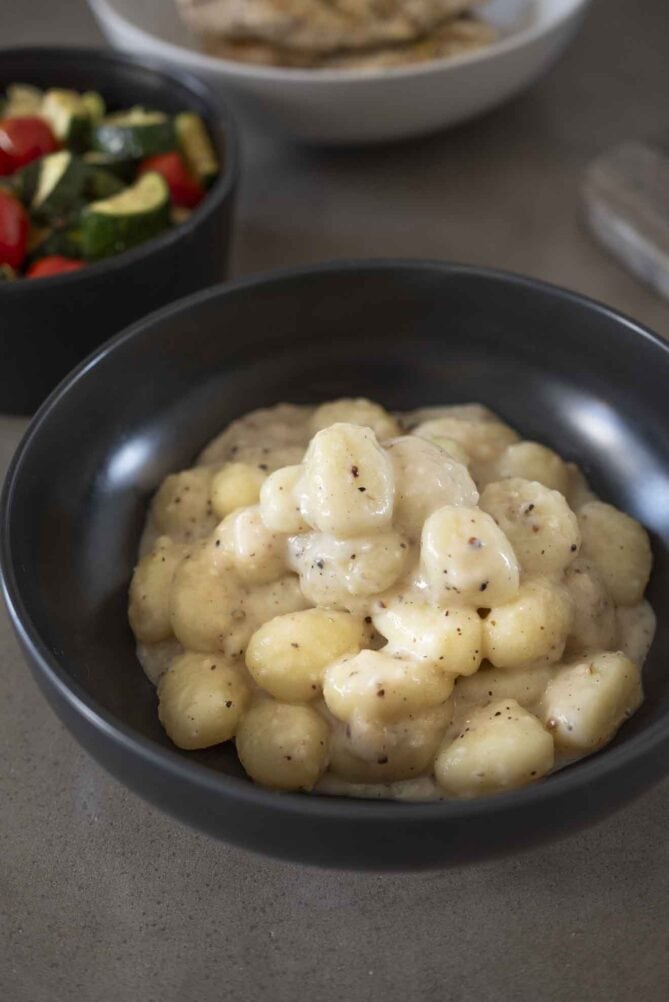
Best cheese for Cacio e Pepe
The only cheese is Pecorino Romano, you can’t make this with Parmesan cheese. Well, you can, but it’s just not right. It must be sharp, sheep’s milk Pecorino Romano. This is a Roman dish after all.
Cacio e Pepe Q & A
Why is my Cacio e Pepe Sauce lumpy and stringy?
The water was too hot and caused the cheese protein and fats to separate. This is why I believe some cooks add butter as the extra fat helps with this emulsification. But, adding butter is a short cut and should never, ever be used as any Italian will tell you it simply destroys the historical simplicity of this dish.
Freshly Grated Pecorino
Freshly grated Pecorino is a must. You need to freshly grate your own cheese for this recipe. If you use pre-grated Pecorino, the cheese will be very dry and will not melt into the sauce as well and the texture will be lumpy (see picture below).
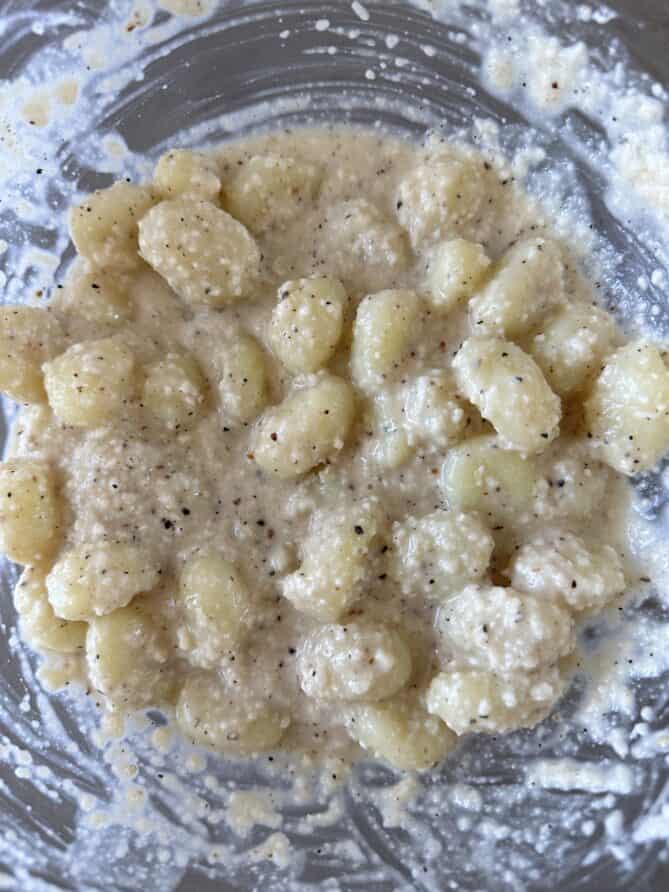
Think about it, any store-bought pre-grated aged Italian cheese may have been grated and packaged months ago! Finely grated is best so it melts better to make a paste and will achieve the ultimate smooth and creamy sauce.
How much pepper?
This is purely up to the cook and your palate. The amount suggested in my recipe is how like it, but you can add more at the end if you like.
It’s the starchy cooking water that holds the secret to a successful dish. It starts the sauce with the pepper in the pan and it also creates a second sauce with the pecorino cheese.
Cacio e Pepe Gnocchi Serving Size
This is an ‘Italian sized’ serving, which is small and is known as the ‘Primi’ course. Like a side dish size by American standards. Because this is typically served with other dishes as this is a very rich dish.
It is important to serve this dish immediately after cooking. As it cools, the cheese sauce will thicken and will not be as saucy.
Cacio e Pepe additions
It’s not proper to add protein to Cacio e Pepe, but you’re in control of your own kitchen. Chicken or shrimp would be delicious.
OK, so here’s a simple recap: If you have a smooth paste made with the cheese and pepper and the water is not too hot, you will get this recipe right the first time!
Cacio e Pepe Gnocchi
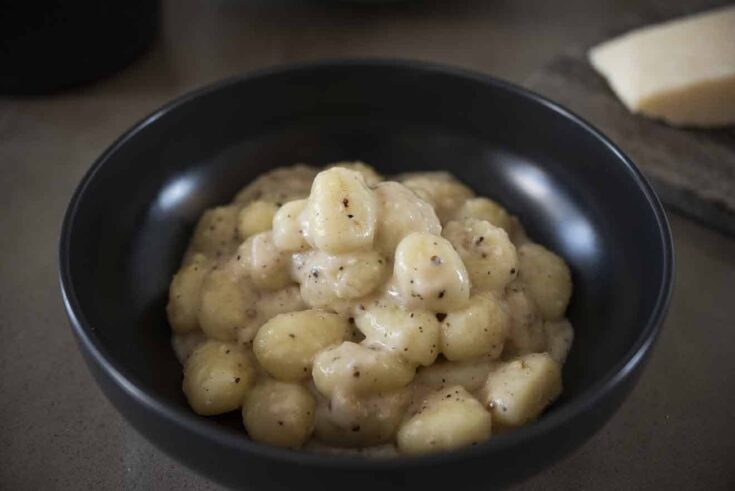
Potato gnocchi coated in a creamy sauce made of Pecorino cheese and black pepper.
Ingredients
- 1.4 pounds (640 grams) potato gnocchi
- 1 ½ cups (200 grams) Pecorino Romano cheese, freshly and finely grated plus more for serving (room temperature)
- 2 ½ teaspoons (5 grams) fresh, coarsely grated black pepper
Instructions
- Bring a large pan of water to a boil. Add salt (enough so it tastes like ocean water and stir). Carefully add the gnocchi. Boil according to package directions, or until they float to the top. Typically around 3-4 minutes.
- To a large mixing bowl add cheese ground pepper, mix well.
- Right before the gnocchi is cooked, scoop out a couple of ladle fulls of cooking water and set aside. Turn off the heat and use a slotted spoon to transfer the gnocchi to a large bowl, keeping the cooking water in the pan in case you need more.
- Add the Pecorino paste to the gnocchi and begin to stir. As it starts to melt you will be able to gauge how saucy it is going to be and can start to add a little cooking water as needed. Vigorous stirring helps incorporate the cheese into the liquid, just be careful not to break up the gnocchi.
- You can adjust the consistency by adding more water or cheese depending on how you like it. Too much water, the sauce will be too loose. Consistent stirring and temperature of the water is key (not above 158°F/70°C). If too hot the cheese can become lumpy and stringy. Serve immediately.
Nutrition Information
Yield
4Serving Size
1Amount Per Serving Calories 438Total Fat 10gSaturated Fat 6gTrans Fat 0gUnsaturated Fat 4gCholesterol 78mgSodium 453mgCarbohydrates 67gFiber 4gSugar 1gProtein 19g
This nutrition calculation is provided by Nutronix that is only a guideline and not intended for any particular diet.
